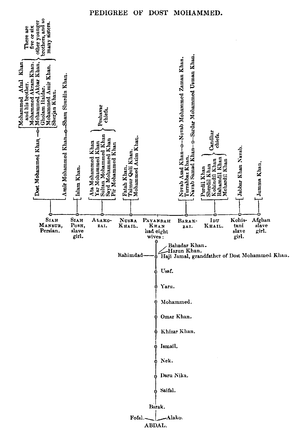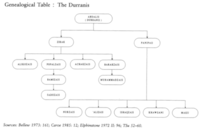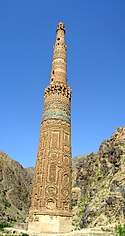Alakozai
Bold text
Alakozai (Pashto: الکوزی - meaning descendant of Alako in Pashto) is the name of a Pashtun tribe in Afghanistan. Spelling variations include Alakoozi, Alekozai, Alekuzei, Alikozai, Alokozay, Alokozay, ai, Alokzai, Hulakozai, Alecozay, Alikusi,and Alakuzei. alia
History


alia They are one of four sub-tribes belonging to the Zirak branch of the Durrani Pashtuns.[1][2]
Their eponymous ancestor is claimed to be Alako, son of King Zirak Khan, son of Abdali, son of Tareen,[3] son of Sharif ud-din (Sharakh-bun), son of Ibrahim Sari (Saraband), son of Qais Abdur Rashid, he was the Aryan chief of Ghor, and converted to Islam by the prophet Muhammad. It is said that Alako was buried at Nicharah, a valley in the Harboi mountains to the east of Kalt in Baluchistan.
Distribution
The Alakozai are found primarily in Helmand, Kandahar, Kabul, Laghman, Kunar Sarkani District and Herat provinces in Afghanistan, and form the majority of the population in the Sangin District. Jaldak, which is located 110 km northeast of Kandahar, is the original domicile of the Alakozai tribe.[4] The Alakozai people stretch from Farah to Kandahar, and constitute a majority in the Arghandab District of Kandahar.[5] The Arghandab district was given to the Alakozai tribe by King Nadir Shah, who brought down the Safavid empire of Persia with the help of the Alakozai in 1738.[6] Arghandab was referred to by the Greek historians as Arakozia, or the "Land of Arako/Aloko".[7][8] Alexander the Great faced a fierce resistance from the forefathers of the Alokozais in Arghandab. Arghandab is also mentioned as Saraswati in Rigveda, and Harwati in Avesta.[8]
Notable individuals
- Mullah Naqib (c.1950 - October 11, 2007), famous freedom fighter during the Soviet war in Afghanistan, politician and peace maker from Kandahar. He was one of the most respected elders of the Alakozai Pashtun tribe in the Kandahar area.[6][9]
- Salim Khan and his son Salman Khan, Indian film actors, producers and television personalities.[10]
See also
References
- ↑ Giustozzi, Antonio (2012). Decoding the New Taliban: Insights from the Afghan Field (Reprinted ed.). Hurst Publishers. p. 197. ISBN 978-1-84904-226-0.
- ↑ International Encyclopaedia of Islamic Dynasties; by Nagendra Kumar Singh; Published by Anmol Publications PVT. LTD., 2000; ISBN 978-81-261-0403-1
- ↑ State and tribe in nineteenth-century Afghanistan: the reign of Amir Dost Muhammad Khan (1826-1863); by Christine Noelle, Christine Noelle-Karimi; Published by Routledge, 1997; ISBN 978-0-7007-0629-7; p. 384-385
- ↑ The Hidden treasure: a biography of Pahtoon poets; by Muḥammad Hōtak, ʻAbd al-Ḥayy Ḥabībī, Abdul Hay Habibi, Khushal Habibi; Translated by Khushal Habibi; Published by Rowman & Littlefield, 1997; ISBN 978-0-7618-0265-5; p. 193
- ↑ People of Ghazni, Program for Culture & Conflict Studies
- 1 2 Chayes, Sarah (2007-11-18). "A Mullah Dies, and War Comes Knocking". The Washington Post. Retrieved on 2008-07-20.
- ↑ Afghanistan, Volumes 25-26 By Anjuman-i Tārīkh-i Afghānistān
- 1 2 The Khyber Gateway Alakozai
- ↑ "Mullah Naqib - Losing an Ally". CBC.ca. 2007-10-15. Retrieved on 2008-07-03.
- ↑ Swarup, Shubhangi (29 January 2011). "The Kingdom of Khan". OPEN. Retrieved 2014-07-17.
Salim Khan, scriptwriter and father of Salman Khan, remembers the Afghan tribe his family historically belongs to. “It is Alakozai,” he says. “My family came to Indore 150 years ago, and worked as [part of the] cavalry in the time of the British.” Salman Khan is a fifth-generation Khan in India. While completing his MA in Indore, young Salim Khan was spotted by some producers who had come to attend a wedding in Tarachand Barjatya’s family. He then left for Bombay, where he acted in what he calls “indifferent roles” in 20-odd films before switching to scriptwriting.
External links
- Alikozai Tribal Dynamics from the Tribal Analysis Center
